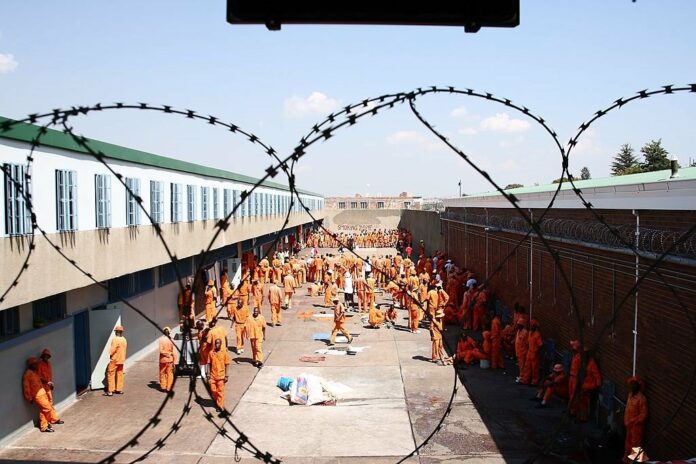Mdu Ndzingi/ Drum Magazine/Gallo Images/Getty Ima
- Only 4 138 of the about 19 000 inmates eligible for special early parole due to the Covid-19 pandemic, have been released by 24 June.
- This eased the overpopulation in South Africa’s prisons from 30.68% to 24.75%.
- The rate of imprisonment is increasing faster than the Department of Correctional Services’ rate of developing new infrastructure, said Justice Minister Ronald Lamola.
Less than a quarter of the 19 000 inmates eligible for early parole to ease overcrowding and alleviate the effects of the Covid-19 pandemic have been released.
In response to a parliamentary question by ANC MP China Dodovu, Justice Minister Ronald Lamola said “minimum progress has been made due to the processes to be followed when releasing sentenced offenders on parole”.
“On 11 May 2020, the department began with the process to release selected low-risk offenders and initial releases started from 20 May 2020, as at 24 June 2020 the total number offenders released was 4 138,” reads Lamola’s reply.
In a proclamation gazetted on 8 May, President Cyril Ramaphosa authorised the release on parole of low-risk inmates to ease overcrowding and curb the spread of Covid-19 in prisons. At the time it was reported that 19 000 inmates would be eligible for this parole.
According to Lamola, before the releases, the total prison population was 154 943 – of which 101 928 were sentenced inmates and 53 015 remand detainees and other un-sentenced inmates.
READ | 1 217 inmates and 1 028 officials infected with Covid-19, recoveries at 74% – Correctional Services
This meant overpopulation was at 30.68%, making physical distancing difficult.
“After the releases as at the 24 June 2020 inmate population was 147 922 consisting of (95 159 sentenced offenders and 52 763 remand detainees and other un-sentenced inmates) which brought the overcrowding level to 24.75%,” reads Lamola’s answer.
Most of the released inmates are in the Western Cape, with 998, followed by KwaZulu-Natal’s 882 and Gauteng’s 730.
Lamola said plans have been made to integrate the inmates back into society in a bid to avoid re-offending.
“As indicated, only low-risk offenders who meet all the requirements and conditions for placement on parole, will be placed on parole. The requirement that only offenders who have undergone relevant rehabilitation programmes aimed at addressing their offending behaviour would qualify for placement as this would minimise the risk of re-offending,” reads his answer.
“There are two additional requirements for placements on parole include taking of fingerprints and DNA samples for comparison with the South African Police Services (SAPS) database as a prerequisite for placement.”
Furthermore, every qualifying sentenced offender’s profile would be assessed and considered individually by the parole boards before they make their recommendations for placement on parole.
ALSO READ | Covid-19 parole dispensation: More than 1 800 prisoners already released
This will include allowing victims to make representations why an offender should not be placed on parole. All relevant factors will be taken into consideration during this process, which will include any prior convictions for violent offences committed.
DA MP George Michalakis asked what effect the prison overcrowding has on the rehabilitation of inmates.
“The rate of imprisonment in our country for both sentenced and awaiting trial offenders is increasing at a rate that surpasses our rate of developing new infrastructure,” reads Lamola’s response.
“Our prison population is largely constituted by those from disadvantaged backgrounds, in particular, young black males. Budget constraints continue to be a challenge in developing new infrastructure and the old infrastructure is also a challenge in providing effective rehabilitation programmes in old prison buildings.”
Lamola said government is examining the criminal justice system in areas such as sentencing so that incarceration does not become the only option for such crimes.
“Secondly, we have started to review some of our policies and we are looking forward to thoughtful contributions which will emanate from public debates through the legislative process so that together, we can address overcrowding challenges in our correctional centres.”
He said overcrowding leads to, among others, the following consequences:
- Minimising available bed space;
- Hampering maintenance of infrastructure;
- Negatively impacting the health conditions of inmates;
- Impeding security management of inmates;
- Increasing gang mobilisation and activities;
- Reduced safety of officials; and
- The capacity of officials to render development and rehabilitation programmes for offenders is also reduced.
